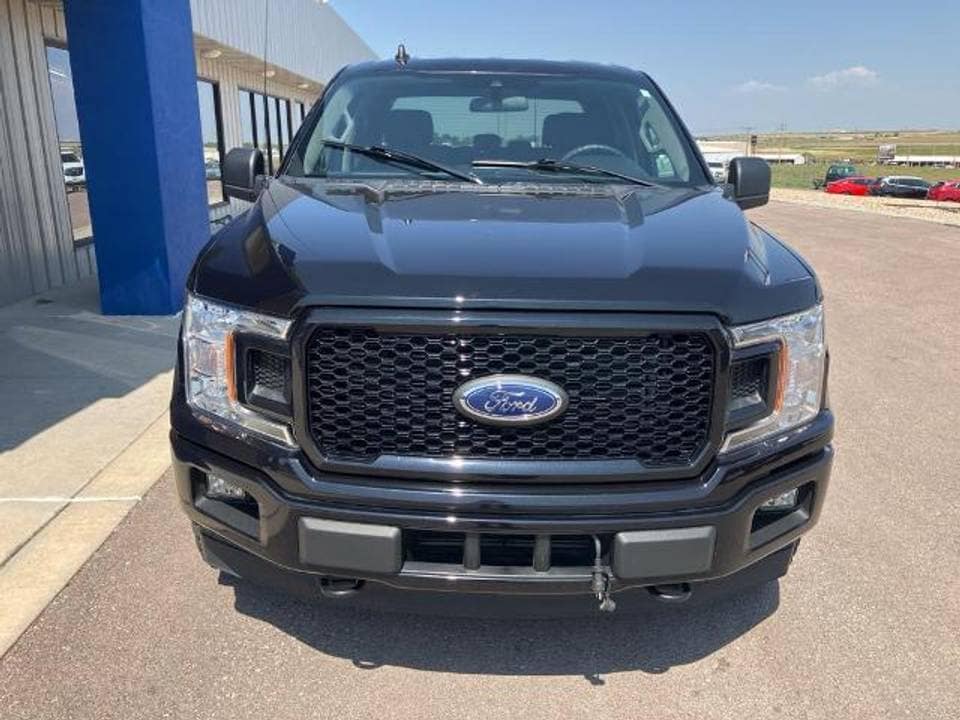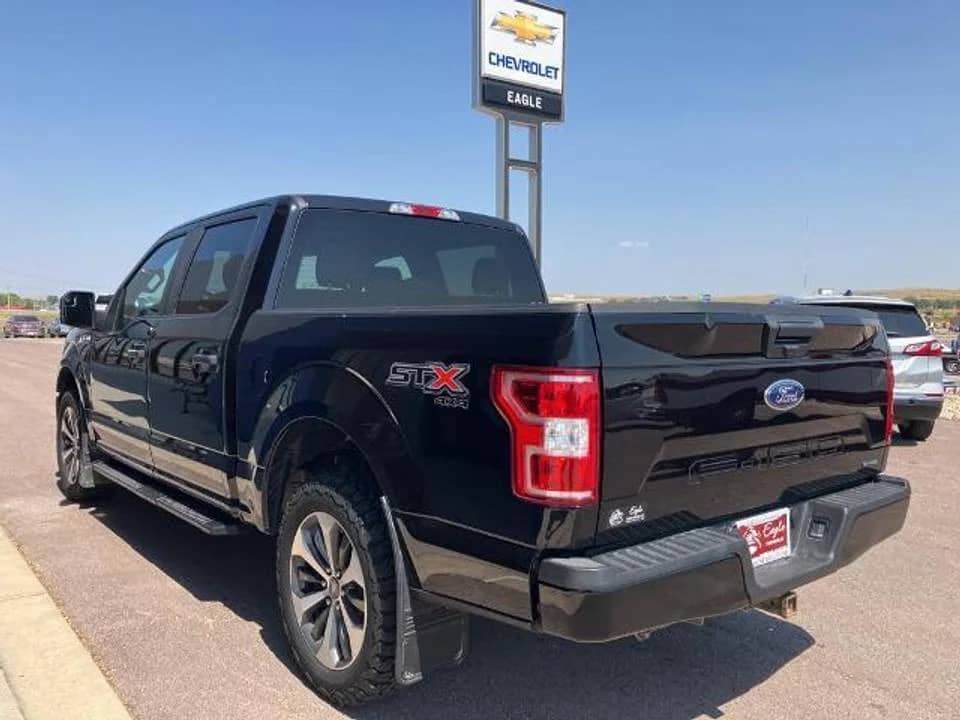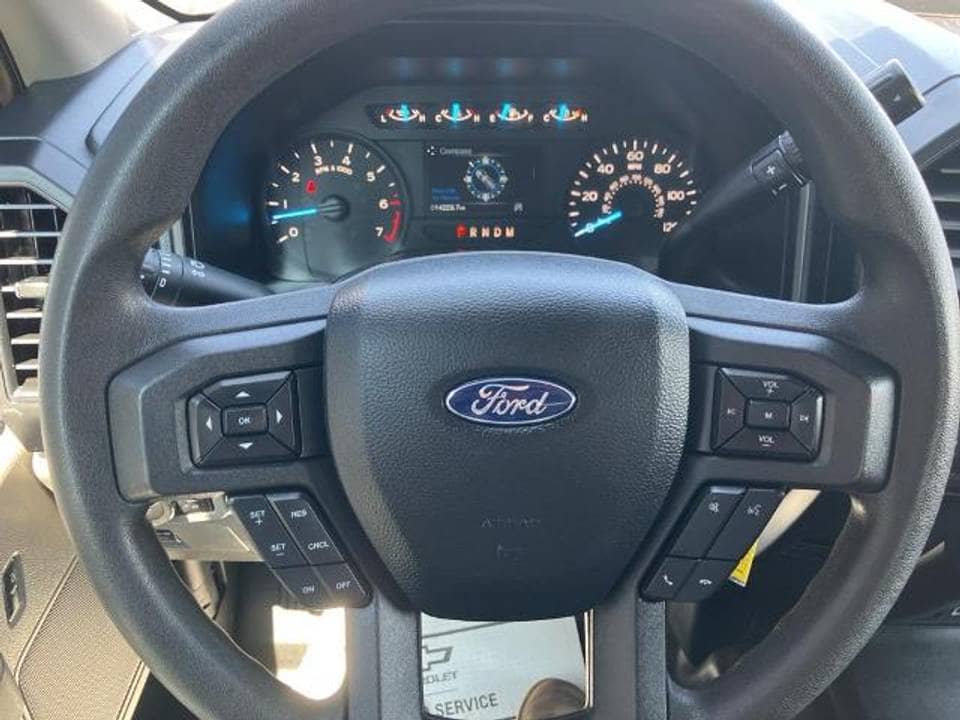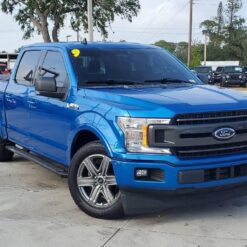Description
Used 2019 Ford F-150 for Sale
Mileage
14,227
Ext. Color
Agate Black
Int. Color
Black premium cloth
Engine
gas
Transmission
automatic
Drivetrain
four wheel drive
MPG
18/23 City/Hwy MPGBased on model year EPA mileage ratings for a standardly equipped F-150. Use for comparison purposes only. Your mileage will vary depending on how you drive and maintain your vehicle, driving conditions, battery-pack age/condition and other factors.
20 Combined MPG
Horsepower
325 hp
Max Towing Capacity
12,700 lbs
Standard Payload Capacity
1,680 lbsBased on vehicle with no options selected. Vehicle options may impact payload capacity. Contact dealer to confirm.
Bed Length
5’7”
Seats
6Based on default model values and available option information. Contact dealer to confirm.
VIN
1FTEW1EP8LKE00753
Stock #
P2113
2019 Ford F-150
The 2019 Ford F-150 is a remarkable choice for consumers seeking a reliable and versatile pickup truck. As one of the best-selling vehicles in America, it continues to set the standard in the competitive truck market. At DMV Used Cars LLC, we recognize the importance of providing our customers with detailed insights into this model year, highlighting its features, specifications, and capabilities that make it an excellent option for various driving needs.
Overview of the 2019 Ford F-150
The 2019 Ford F-150 is available in seven distinct trims: XL, XLT, Lariat, King Ranch, Platinum, Limited, and Raptor. Each trim offers unique features tailored to different preferences and requirements. The truck’s design emphasizes functionality while maintaining a rugged aesthetic that appeals to both urban and rural drivers alike.
Engine Options
One of the standout aspects of the 2019 F-150 is its diverse engine lineup. Customers can choose from six different engines:
- 3.3-liter Ti-VCT V6: Producing 290 horsepower and 265 lb-ft of torque.
- 2.7-liter EcoBoost V6: Offering 325 horsepower and 400 lb-ft of torque.
- 5.0-liter Ti-VCT V8: Delivering 395 horsepower and 400 lb-ft of torque.
- 3.5-liter EcoBoost V6: Generating 375 horsepower and an impressive 470 lb-ft of torque.
- High-Output 3.5-liter EcoBoost V6 (Raptor only): Producing a robust 450 horsepower and 510 lb-ft of torque.
- 3.0-liter Power Stroke Turbo Diesel: Providing a balance between power and efficiency with 250 horsepower and 440 lb-ft of torque.
This variety allows buyers at DMV Used Cars LLC to select an engine that best suits their driving style or towing needs.
Performance Capabilities
The performance capabilities of the 2019 Ford F-150 are among its strongest selling points:
Towing Capacity
The towing capacity varies depending on engine choice and configuration but can reach up to 13,200 pounds when properly equipped with the right engine (typically with the Max Trailer Tow Package). This makes it suitable for hauling trailers, boats, or heavy equipment—ideal for both work-related tasks and recreational activities.
Payload Capacity
In addition to towing capabilities, the 2019 Ford F-150 also boasts impressive payload capacities ranging from approximately 1,500 pounds to over 3,300 pounds, depending on configuration and trim level. This versatility makes it a practical choice for transporting tools or materials.
Interior Features
The interior of the 2019 Ford F-150 is designed for comfort and convenience:
Seating Options
The truck can accommodate up to six passengers with spacious seating arrangements available in various materials including cloth or leather upholstery depending on trim levels.
Technology Integration
Ford has equipped the 2019 Ford F-150 with modern technology features such as:
- SYNC® Infotainment System: Available with Apple CarPlay® and Android Auto™ compatibility for seamless smartphone integration.
- FordPass Connect™: Allows users to connect their smartphones for remote access features like locking/unlocking doors or checking fuel levels.
- B&O Sound System by Bang & Olufsen: An optional premium audio system providing high-quality sound for music lovers.
These technological advancements enhance both entertainment options and connectivity while driving.
Safety Features
Safety has been enhanced across all trims for the 2019 Ford F-150 model year:
Advanced Safety Technologies
Notable safety features include:
- Pre-Collision Assist with Automatic Emergency Braking
- Blind Spot Information System (BLIS)
- Adaptive Cruise Control
These technologies contribute significantly to driver confidence on highways as well as city streets—an essential consideration for families purchasing used vehicles at DMV Used Cars LLC.
Customization Options
Ford offers numerous customization options for buyers looking to personalize their trucks:
Exterior Accessories
From running boards to bed liners, there are many accessories available that enhance both functionality and aesthetics.
Performance Upgrades
For those interested in improving performance further, options such as throttle controllers can enhance throttle response by modifying how quickly power is delivered based on pedal input.
Off-Road Capability (Raptor)
For enthusiasts seeking off-road adventures, the Raptor variant stands out with specialized features such as:
- High-output engines
- Off-road suspension systems
- Beadlock-capable wheels
These enhancements make it capable of tackling rugged terrains while maintaining stability—perfect for adventurous drivers looking at used models from DMV Used Cars LLC.
Fuel Efficiency
Fuel efficiency varies based on engine choice but generally ranges from approximately:
19 mpg city / 26 mpg highway for models equipped with smaller engines like the EcoBoost V6; larger engines may yield lower figures under heavy loads. This efficiency makes it a practical choice not only for daily driving but also for work-related tasks where fuel economy matters.
2019 Ford F-150 Oil Filter: Everything You Need to Know.
The 2019 Ford F-150 is a legendary full-size pickup known for its strength, reliability, and performance. Whether you use your truck for work, recreation, or daily driving, routine maintenance is essential to keep it running smoothly. One of the most crucial components in your truck’s health is the oil filter—a small part with a big job: keeping your engine oil clean and your engine protected.
In this guide, you’ll learn:
What oil filter your F-150 uses
Options based on engine type
Best aftermarket oil filters
Replacement intervals
How to replace it yourself
Cost considerations
What Oil Filter Does the 2019 Ford F-150 Use?
The oil filter you need depends on the engine under your hood. The 2019 F-150 offers six different engines, and each one may require a different oil filter.
OEM Ford Motorcraft Oil Filter Guide:
| Engine | Ford Motorcraft Filter |
|---|---|
| 3.3L Ti-VCT V6 | FL-500S |
| 2.7L EcoBoost V6 | FL-2062A |
| 3.5L EcoBoost V6 | FL-500S |
| 3.5L High-Output EcoBoost V6 (Raptor) | FL-500S |
| 5.0L V8 Ti-VCT | FL-500S |
| 3.0L Power Stroke Diesel V6 | FL-2081 |
Motorcraft is Ford’s OEM brand, designed specifically for your engine’s oil pressure and flow requirements. Using an OEM filter ensures compatibility and performance.
Best Oil Filters for the 2019 Ford F-150
While Motorcraft filters are highly recommended, there are also premium aftermarket options that offer advanced filtration and longer service life—ideal for synthetic oil users.
Top-Rated Oil Filters:
| Brand | Model | Benefits |
|---|---|---|
| Motorcraft | FL-500S / FL-2062A | OEM quality, anti-drainback valve, budget-friendly |
| Mobil 1 | M1-212A | Extended performance, synthetic media, 20,000-mile protection |
| Bosch | 3330 / 3323 | Filtech media for high dirt-holding capacity |
| K&N | HP-2011 | High flow, race-ready design, easy removal |
| FRAM Ultra Synthetic | XG10575 | Dual-layer synthetic, 99%+ efficiency |
Choose a filter that matches your oil type and driving habits. For frequent towing or extended oil intervals, premium filters offer extra protection.
When to Change Your Oil Filter
Ford recommends replacing the oil filter every time you change the oil. The oil change interval depends on your engine and oil type:
- Conventional Oil: Every 5,000–7,500 miles
- Synthetic Oil: Up to 10,000 miles
- Heavy-duty use (towing, extreme temperatures): More frequent changes recommended
Pro Tip: A clean oil filter prevents dirt and debris from circulating, reducing engine wear and extending engine life.
How to Replace Your Oil Filter (DIY Guide)
Changing your oil filter is a straightforward task if you’re comfortable doing your own oil changes.
What You’ll Need:
- Correct Motorcraft oil filter
- Oil filter wrench
- Drain pan
- 6–8 quarts of engine oil (check your engine spec)
- Gloves, rags, and funnel
Steps:
- Warm the engine for a few minutes, then turn it off.
- Remove the drain plug and let the oil drain fully.
- Use the oil filter wrench to remove the old filter.
- Apply new oil to the rubber gasket on the new filter.
- Install the new filter—hand-tighten, then add a 3/4 turn.
- Replace drain plug, refill oil, and check levels.
- Start the engine and check for leaks.
Dispose of old oil and filters properly at an auto shop or recycling center.
Cost to Replace an Oil Filter
DIY Cost:
- Oil Filter: $10–$15
- Full Synthetic Oil (6–8 quarts): $40–$70
- Total: $50–$90
Professional Service:
- Dealership or shop: $80–$150 (includes parts and labor)
DIY saves money, especially if you already have the tools.
Conclusion: Small Part, Big Protection
The 2019 Ford F-150 oil filter may be small, but it plays a massive role in protecting your engine from damage. Using the right filter—OEM or high-quality aftermarket—and replacing it on schedule ensures your F-150 continues to deliver strong, reliable performance for years to come.
Key Takeaways:
- Use the correct oil filter based on your engine type
- Replace the filter with every oil change
- Consider premium filters for better protection
- DIY oil changes save time and money
Take care of your oil filter, and your 2019 Ford F-150 will take care of you.
In summary, the 2019 Ford F-150 combines versatility with advanced technology, making it suitable for a wide range of consumers—from families needing space to contractors requiring reliability in tough conditions. Its robust engine lineup ensures that there’s an option for every need while maintaining high standards in safety features and interior comfort. With its continued reputation as America’s best-selling vehicle over decades, it remains a top contender in its class due to its blend of capability, comfort, technology integration, safety features, customization options, off-road prowess (in Raptor form), and overall value proposition—all key considerations when selecting used cars at DMV Used Cars LLC.
2019 Ford F-150 Miles Per Gallon (MPG): Full Efficiency Breakdown in 600 Words
The 2019 Ford F-150 is a powerful, versatile, and best-selling full-size pickup truck, renowned for its towing capacity, engine variety, and durability. But alongside performance and strength, many buyers consider fuel efficiency an essential factor. With six different engine options, multiple drivetrains, and trims ranging from work-ready to luxury-grade, the 2019 Ford F-150 MPG varies widely—and that’s a good thing, because it means there’s an F-150 for every type of driver.
In this guide, we’ll explore: Official EPA MPG ratings
MPG by engine type and drivetrain
Real-world fuel economy reports
How configuration affects MPG
Tips to improve efficiency
2019 Ford F-150 MPG by Engine and Drivetrain
The 2019 Ford F-150 offers impressive fuel efficiency for a full-size truck—especially when paired with Ford’s lightweight aluminum-alloy body and advanced 10-speed automatic transmission (standard on most engines).
EPA-Estimated MPG Ratings by Engine:
| Engine | Drivetrain | City | Highway | Combined |
|---|---|---|---|---|
| 3.3L V6 | 4×2 | 19 MPG | 25 MPG | 22 MPG |
| 4×4 | 18 MPG | 23 MPG | 20 MPG | |
| 2.7L EcoBoost V6 | 4×2 | 20 MPG | 26 MPG | 22 MPG |
| 4×4 | 19 MPG | 24 MPG | 21 MPG | |
| 5.0L V8 | 4×2 | 17 MPG | 23 MPG | 19 MPG |
| 4×4 | 16 MPG | 22 MPG | 18 MPG | |
| 3.5L EcoBoost V6 | 4×2 | 17 MPG | 23 MPG | 19 MPG |
| 4×4 | 16 MPG | 22 MPG | 18 MPG | |
| High-Output 3.5L EcoBoost (Raptor) | 4×4 | 15 MPG | 18 MPG | 16 MPG |
| 3.0L Power Stroke Diesel V6 | 4×2 | 22 MPG | 30 MPG | 25 MPG |
| 4×4 | 20 MPG | 25 MPG | 22 MPG |
The best fuel economy comes from the 3.0L Power Stroke Diesel V6, offering up to 30 MPG on the highway. The 2.7L EcoBoost is the most efficient gas-powered option.
Real-World Fuel Economy
While EPA ratings provide a standardized comparison, real-world MPG often depends on driving style, terrain, and how the truck is used.
Owner-Reported Averages:
- 2.7L EcoBoost: 20–24 MPG combined
- 3.5L EcoBoost: 17–20 MPG combined
- 5.0L V8: 16–19 MPG combined
- 3.0L Diesel: 24–27 MPG combined
- Raptor (High-Output 3.5L): 14–16 MPG combined
Real-world numbers tend to align closely with EPA estimates for drivers using Eco mode and maintaining steady speeds. However, towing, heavy payloads, city traffic, and aggressive acceleration can significantly lower MPG.
Factors That Affect MPG
1. Engine Type
Turbocharged EcoBoost engines offer more torque at lower RPMs, allowing for better fuel efficiency under light loads. The diesel engine excels in long-distance highway travel.
2. Drivetrain
- 4×2 models are more fuel-efficient than 4x4s, which add weight and drivetrain drag.
- However, 4x4s offer better off-road and all-weather performance.
3. Cab & Bed Configuration
- Larger SuperCrew cabs and longer beds add weight and reduce aerodynamics, slightly lowering MPG.
- Regular Cab models with shorter beds achieve better fuel economy.
4. Driving Behavior
- Smooth, consistent driving improves fuel efficiency.
- Sudden acceleration, hard braking, and high speeds lower MPG.
Fuel Tank Sizes & Range
| Tank Size | Range (approx.) |
|---|---|
| 23 gallons (standard) | Up to 690 miles (with diesel engine) |
| 26 or 36 gallons (available on some trims) | Up to 1,080 miles (diesel highway driving) |
A diesel-powered F-150 with the 36-gallon tank can travel over 1,000 miles on a single tank—perfect for long hauls.
Tips to Improve Fuel Efficiency
- Use Eco Mode – Adjusts throttle and transmission for better efficiency.
- Maintain Proper Tire Pressure – Underinflated tires reduce MPG.
- Remove Excess Weight – Unload tools or gear you don’t need.
- Limit Idle Time – Especially in cold weather, idling burns fuel unnecessarily.
- Keep Up with Maintenance – Clean air filters, fresh oil, and tuned engines all help.
Conclusion: Power Meets Practicality
The 2019 Ford F-150 proves you don’t have to sacrifice efficiency for capability. With a wide range of engine options, you can choose a setup that delivers the power you need with the MPG you want.
Key Takeaways:
- Best MPG: 3.0L Diesel V6 – Up to 30 MPG highway
- Best gas efficiency: 2.7L EcoBoost – 26 MPG highway
- Average across trims: 16–25 MPG depending on setup
- Smart driving and regular maintenance = better MPG
Whether you’re towing, commuting, or heading off-road, the 2019 Ford F-150 keeps fuel economy competitive without compromising performance.
2019 Ford F-150 Air Filter: Performance, Maintenance & Replacement Guide
The 2019 Ford F-150 is a powerful, reliable, and capable full-size truck—but to keep it running at peak performance, regular maintenance is essential. One of the most important and cost-effective components to maintain is the engine air filter. Though it’s small and inexpensive, the air filter plays a major role in engine efficiency, fuel economy, and overall performance.
In this detailed guide, you’ll learn:
What type of air filter the 2019 Ford F-150 uses
Differences by engine type
Signs your air filter needs replacement
How often to change it
DIY replacement steps
Best replacement options
What Does the Air Filter Do?
The engine air filter prevents dirt, dust, pollen, and debris from entering your engine’s combustion chambers. Clean air is essential for the engine to burn fuel efficiently, produce power, and reduce emissions.
A clogged or dirty air filter restricts airflow, causing:
- Reduced acceleration
- Lower fuel efficiency
- Rough idling
- Engine strain
Replacing a dirty air filter is one of the simplest ways to restore lost performance.
Air Filter Types by Engine
The 2019 Ford F-150 comes with six available engines. While most share similar air filter sizes, it’s important to match the filter to your specific engine.
| Engine | Air Filter Part Number (Motorcraft) |
|---|---|
| 3.3L V6 | FA-1908 |
| 2.7L EcoBoost V6 | FA-1883 |
| 3.5L EcoBoost V6 | FA-1883 |
| High-Output 3.5L EcoBoost (Raptor) | FA-1883 |
| 5.0L V8 | FA-1883 |
| 3.0L Power Stroke Diesel V6 | FA-1902 |
Motorcraft is Ford’s OEM parts brand and is highly recommended for exact fit and reliability.
When to Replace the Air Filter
Ford’s recommendation:
- Every 30,000 miles under normal driving conditions.
- Every 15,000 miles or less in dusty or off-road conditions.
Signs You Need a New Air Filter:
- Sluggish acceleration
- Decreased MPG
- Check Engine Light
- Visual inspection shows dirt buildup or discoloration
Inspect your air filter every 10,000–15,000 miles for peace of mind.
DIY: How to Replace the Air Filter (Step-by-Step)
Tools Needed:
- None! This is one of the easiest DIY maintenance jobs.
Steps:
- Pop the hood and locate the air filter box. It’s usually a large black plastic box near the engine.
- Unclip or unscrew the air filter housing.
- Remove the old air filter.
- Wipe out any debris or dust from the housing with a clean cloth.
- Insert the new air filter with the rubber seal facing up.
- Secure the airbox lid back in place.
This simple task takes less than 10 minutes and can save money over a shop visit.
Best Replacement Air Filters for the 2019 Ford F-150
You can choose between OEM-style filters or high-performance aftermarket filters.
Top Picks:
| Brand | Model | Type | Benefits |
|---|---|---|---|
| Motorcraft | FA-1883 / FA-1908 | OEM | Exact fit, excellent filtration |
| FRAM Extra Guard | CA10859 | Paper | Great value, solid protection |
| K&N High-Flow | 33-2385 | Reusable cotton | Increased airflow, washable |
| PurolatorONE | A25863 | Advanced synthetic | Excellent for dusty areas |
| Bosch Workshop | 5333WS | Standard paper | Budget-friendly, OEM equivalent |
K&N filters are reusable and designed for performance, making them a good long-term investment if you drive frequently.
Cabin Air Filter vs. Engine Air Filter
Don’t confuse the engine air filter with the cabin air filter.
- Engine Air Filter: Feeds clean air to the engine.
- Cabin Air Filter: Cleans air entering the cabin via HVAC system.
Replacing both regularly keeps your truck breathing clean inside and out.
Conclusion: Breathe Easy, Drive Strong
The engine air filter might be a small component, but it plays a big role in the overall health and efficiency of your 2019 Ford F-150.
Key Takeaways:
- Replace every 30,000 miles (or sooner in dusty areas).
- Use a filter matched to your engine.
- A clean air filter = better MPG, stronger performance, and less engine wear.
- Simple DIY task = money saved and confidence gained.
Regular air filter maintenance is one of the easiest and most affordable ways to protect your F-150’s performance for the long haul.
















Reviews
There are no reviews yet.